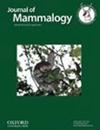Latrine site selection by African clawless otters, Aonyx capensis, and their behavior during latrine visitations
IF 1.6
3区 生物学
Q2 ZOOLOGY
引用次数: 0
Abstract
Latrine sites are used as areas for the deposition of scent-containing excretions and play important roles in intraspecific olfactory communication, territoriality, sexual attraction, and defense behaviors of many mammals. African clawless otters (Aonyx capensis) likely use latrine sites as primary areas for scent marking and scent communication but no studies to date have investigated their potential role or site selection. We assessed latrine site selection at 2 spatial scales (micro- and macroscale) and recorded behaviors via camera trap recordings. Thirty-eight latrine sites were identified and assessed at 2 locations in Mtunzini on the north coast of KwaZulu-Natal, South Africa (uMlalazi Nature Reserve and Zini Fish Farm) during the months of August to November 2021. Latrine sites were identified through several intensive surveys, while we characterized nonselected sites through a systematic sampling approach. Latrine and control sites were inventoried along a 52-m buffer around all water bodies in both study areas. At each site we measured a series of potential environmental predictors, including horizontal and vertical vegetation cover, surface slope, and averaged wind speeds for days classified as relatively wind-still and relatively windy. To assess the relative role of various environmental predictors, we used a binomial generalized linear model resource selection function to model both spatial scales of latrine site selection. The majority of latrine sites were located at the ecotone between 2 vegetation units or between a vegetation unit and a water source. At a macroscale, latrine sites were associated with areas containing little vegetative substrate cover and minimal canopy cover. The top-ranked models at the microscale also indicated that latrine sites were characterized as occurring in open areas with less canopy and horizontal cover and on flatter areas that are relatively protected against wind. The most common behaviors recorded at 3 latrine sites were the “jiggle dance” (42%) and sniffing (29%). We hypothesize that otters evaluate numerous environmental parameters to enhance the functionality of latrine sites. For example, sites with little vegetative cover may increase the conspicuousness of latrines to conspecifics, while areas exposed to less wind likely aid in the retention of scent. Ongoing research is characterizing the behaviors of otters around latrines and chemical signatures of latrine sites in an effort to facilitate interpretation of their social function to African clawless otters.非洲无爪水獭(Aonyx capensis)的厕所选择及其上厕所时的行为
厕所是许多哺乳动物沉积含气味排泄物的地方,在种内嗅觉交流、领地、性吸引和防御行为中发挥着重要作用。非洲无爪水獭(Aonyx capensis)很可能将厕所作为气味标记和气味交流的主要区域,但迄今为止还没有研究调查过它们的潜在作用或地点选择。我们评估了两个空间尺度(微观和宏观尺度)的厕所地点选择,并通过相机陷阱记录了它们的行为。2021 年 8 月至 11 月期间,我们在南非夸祖鲁-纳塔尔省北海岸的 Mtunzini 的两个地点(uMlalazi 自然保护区和 Zini 养鱼场)确定并评估了 38 个厕所地点。我们通过多次深入调查确定了厕所地点,并通过系统抽样方法确定了非选定地点的特征。我们沿着两个研究区域内所有水体周围 52 米的缓冲区对厕所和对照地点进行了调查。在每个地点,我们都测量了一系列潜在的环境预测因子,包括水平和垂直植被覆盖度、地表坡度以及相对静风日和相对大风日的平均风速。为了评估各种环境预测因子的相对作用,我们使用了二项式广义线性模型资源选择函数来模拟厕所地点选择的两种空间尺度。大多数厕所都位于两个植被单元之间或植被单元与水源之间的生态区。在宏观尺度上,厕所地点与植被基质覆盖率低和树冠覆盖率小的区域相关。在微观尺度上,排名靠前的模型也表明,厕所地点的特点是位于树冠和水平覆盖较少的开阔区域,以及相对避风的较平坦区域。在 3 个如厕地点记录到的最常见行为是 "抖动舞"(42%)和嗅闻(29%)。我们假设水獭会评估许多环境参数,以提高厕所的功能。例如,植被覆盖较少的地点可能会增加厕所对同类的显眼度,而风力较小的区域可能有助于气味的保留。正在进行的研究正在描述水獭在厕所周围的行为以及厕所的化学特征,以帮助解释厕所对非洲无爪水獭的社会功能。
本文章由计算机程序翻译,如有差异,请以英文原文为准。
求助全文
约1分钟内获得全文
求助全文
来源期刊

Journal of Mammalogy
生物-动物学
CiteScore
3.30
自引率
5.90%
发文量
106
审稿时长
4-8 weeks
期刊介绍:
Papers are published on mammalian behavior, conservation, ecology, genetics, morphology, physiology, and taxonomy.
 求助内容:
求助内容: 应助结果提醒方式:
应助结果提醒方式:


